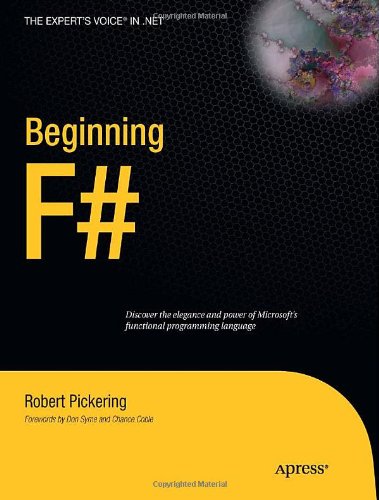Beginning F# book download
Par chaffin manuela le vendredi, janvier 29 2016, 03:42 - Lien permanent
Beginning F# by Robert Pickering


Beginning F# Robert Pickering ebook
Format: pdf
ISBN: 1430223898, 9781430223894
Publisher:
Page: 400
Robert Pickering's Beginning F# Workshop and Progressive.Net. Here are the three possible octatonic or diminished scales beginning with a half step: C – C#/Db – D#/Eb – E – F#/Gb – G – A – A#/Bb; C#/Db – D – E – F – G – G#/Ab – A#/Bb – B; D - D#/Eb – F - F#/Gb – G#/Ab – A – B – C. Shouldn't "*" bind 2 and 3 before 1 is added? I'm just beginning F# myself, so I appreciate your struggles. This is a very simple kata, so if you already know F#, there will be nothing new to see here. It's too bad they called it “Expert” in the title – because it is actually a beginning book. Where other languages use a variety of syntactic elements to denote code blocks (semicolons, curly braces, BEGIN, END, etc…) F# uses whitespace (see whitespace note below). John 1 1In the beginning was the Word, and the Word was with God, and the Word was God. 3All things were made by him; and without him was not any thing made that was made. I'll in London on the 10th/11th May giving a two day course entitle “Beginning F# Workshop” in conjunction with the lovely folks at Skills Matter. The "let" expression is at the core of F#'s functional syntax, and is used in a variety of ways: defining a function, defining a sequence, and so on. We don't bother to ask hard question, to wrestle with the music as a listener- reading from beginning to end. An introductory look at record types, a useful F# language feature. 2The same was in the beginning with God. It explains things in a progressive and hands-on fashion. Back at the beginning of the year I launched a programming contest for using F# with Autodesk products. ListingTroll ["alice"; "bob"];; val it : string = "two elements beginning with "alice"" > listingTroll [1; 2; 3];; val it : string = "lots of elements" > listingTroll [1];; val it : string = "just 1" > listingTroll [];; val it : string = "empty". F# uses significant whitespace to mark block beginnings and endings. I can't follow all your code, but is the expression (1 + 2 * 3) / 3 really supposed to evaluate to 3? I thought it was cool that in the early chapters the focus with the F# code is to provide examples that you can just get running straight away instead of having to worry about the need to structure your code in a maintainable way.
Mapping the Total Value Stream: A Comprehensive Guide for Production and Transactional Processes ebook
Astronomical formulae for calculators pdf